
About the Book
-
Author:
- Winifred Conkling
- Genre:
- Memoir / Biography
- Voices:
- Cis Girl
- Straight
- White (Non-Specified)
Cover Story: Biography
Drinking Buddy: Can You Buy Me a Drink?
MPAA Rating: PG-13 (adult situations)
Talky Talk: The More Things Change
Bonus Factors: Feminism, Abortion
Bromance Status: Does it Have to Be Gendered?
Cover Story: Biography
Nice, subtle picture of the subject. The ‘Ms.’ refers both to the feminist rejection of the Miss/Mrs. suffix, and her role in the founding of Ms. magazine. I used to have groovy glasses like that, but my wife made me get new frames.
The Deal:
So who was Gloria Steinem? Almost anyone can tell you she was a famous feminist. Unfortunately, that’s about all anyone can tell you. This biography delves into Steinem’s role as an activist, speaker, publisher, and human being.
Drinking Buddy: Can You Buy Me a Drink?

Steinem was most active in the 1970s, that disco loving, singles bar, leisure suited, key party era. Time was right for second wave feminism, and Steinem stepped up to role. And contrary to what the incels believe, feminist does not equal man hater or humorless. I’d love to hang out, but I’d know better than to offer to buy her a drink.
MPAA Rating: PG-13 (adult situations)
Steinem had an amazing life. The daughter of a mentally ill woman and an absent father, she grew up poor and was often forced to take care of both herself and her mother. She ultimately went to college, spent time in the UK and India, unknowingly worked for a CIA-backed organization, had an abortion when it was still illegal in the US, campaigned for various causes (especially feminism), went undercover at the Playboy club, and founded a magazine. This was still in an era when women, even college-educated women, were expected to get married and raise a family, and nothing more.
Talky Talk: The More Things Change
Now back in Gloria’s era, women were treated as second class citizens. They were often not taken seriously in business and frequently found themselves paid less than their male counterparts. Male legislators would try to make laws limiting the control they had over their own bodies. Advertising was often sexist and portrayed women as mindless, sexy drones. Rapes often went unprosecuted, and the burden of proof usually fell on the victim. Thank God times have changed, eh?
It was thrilling to read about her fight for the doomed Equal Rights Amendment and how she started what was probably the first women’s magazine that didn’t feature recipes and fashion tips. How to attract advertisers without including anything sexist? How to fight political and educational groups who wanted Ms. off the newsstands and out of the schools? Which political movements should be embraced and which should be avoided?
Bonus Factor: Feminism

Steinem was at the forefront of second-wave feminism, the period when American women, now that they could vote, shifted to other issues, such as abortion, birth control, rape, equal rights, etc. As a publisher and speaker, Steinem often found herself setting policy and sometimes being the face of the movement. This sometimes led to divisions among feminists and other allied causes. She supported Cesar Chavez and the United Farm Workers, but broke with him over his opposition to abortion and birth control. Some of the Ms. staff felt that they should support lesbian causes; others felt that the issue was too radical. And Steinem herself, a pretty blonde woman, subverted the idea that all feminists were just too ugly to get a man. But many feminists thought that Steinem’s good looks were hurting everything they were saying: people took her seriously because she was attractive.
Incidentally, Steinem certainly didn’t fall into the stereotype of the man-hating radical. She had many sexual and emotional relationships with men, but never married until much later in life (to Christian Bale’s father, no less). She simply never felt the need to legally commit to a man.
Bonus Factor: Abortion

Steinem became pregnant in her twenties by her boyfriend. She had no desire to become a mother (at times, she was afraid she’d inherit her mother’s mental illness), nor did she wish to marry the father, as was expected. She elected to have an abortion. This was not then legal in the United States, but she was studying in England and, after jumping through some hoops, had the procedure performed there. She became a staunch advocate of reproductive rights and a woman’s right to have control over her own body.
Bromance Status: Does it Have to Be Gendered?
I enjoyed the human side of Gloria Steinem: the poor kid from Ohio, the world traveler, the uncomfortable public speaker, the mature woman. I hope this book introduces her new a new wave of young feminists.
Literary Matchmaking

Penelope Bagieu’s graphic novel California Dreamin’ tells the life of ‘Mama’ Cass Eliot, another woman with an amazing life.

Veteran actress Sonia Manzano gives us a look at her pre-Sesame Street days in Becoming Maria.

Michelle Quach’s Not Here to Be Liked is about a junior feminist.
FTC Full Disclosure: I received a free copy of this book from the publisher, but no money or draft beer in a pilsner glass (like my parents drank in the ’70s).